Dark Souls offers a formidable challenge that tests players’ skills and patience. This article explores the game’s intricate lore, examining themes of fate and consequence. It delves into gameplay mechanics that emphasize strategic depth and difficulty. Finally, we discuss community engagement and tips for mastering this iconic title.
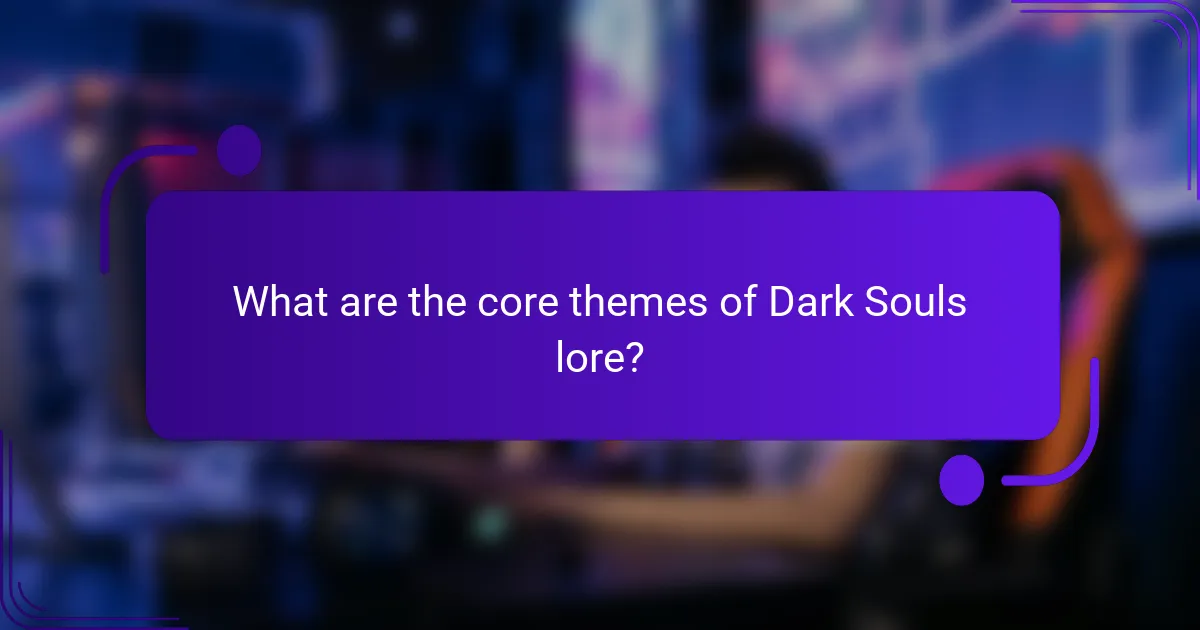
What are the core themes of Dark Souls lore?
The core themes of Dark Souls lore include the cyclical nature of fire and dark, the struggle against fate, and the consequences of choices. These themes explore the interconnectedness of characters and events, creating a rich narrative tapestry. The cyclical nature signifies the endless loop of life, death, and rebirth, while the struggle against fate emphasizes the player’s agency in a predetermined world. Choices made throughout the game lead to various outcomes, highlighting the weight of decisions in a morally complex universe.
How does the interconnected world design enhance storytelling?
The interconnected world design enhances storytelling by creating a rich, immersive experience. Dark Souls exemplifies this through its intricate lore, where each element interlinks with gameplay mechanics and environmental storytelling. The world is designed to encourage exploration, revealing lore through item descriptions, character interactions, and environmental cues. This depth fosters a sense of discovery and challenge, as players piece together the narrative while navigating a complex, interconnected environment. The unique attribute of Dark Souls lies in its ability to convey a compelling story without traditional cutscenes, relying instead on player engagement and interpretation.
Which characters are pivotal in the Dark Souls narrative?
Key characters in the Dark Souls narrative include Gwyn, the Lord of Sunlight; Artorias, the Abysswalker; and Manus, the primeval man. Each character significantly shapes the game’s lore and player experience. Gwyn represents sacrifice and the fading of the Age of Fire. Artorias embodies valor and tragedy, while Manus highlights the themes of humanity and darkness. Their interconnected stories deepen the game’s complex narrative.
What role do the gods play in shaping the game’s universe?
The gods in Dark Souls significantly influence the game’s universe through their actions and the lore surrounding them. They shape the world, its history, and the conflicts that define the gameplay experience. Each god embodies unique attributes that impact their followers and the land, such as Gwyn’s association with light and fire, contrasting with Nito’s dominion over death. Their interactions create a rich narrative backdrop, driving the player’s journey through a world filled with challenges and mysteries. The lore surrounding these deities adds depth, enhancing gameplay by intertwining their legacies with the player’s quest for understanding and survival.
How do player choices affect the lore interpretation?
Player choices significantly shape the interpretation of Dark Souls lore. Each decision influences character interactions, story outcomes, and world events, leading to diverse narrative experiences.
For example, choosing to ally with specific factions can alter the storyline and reveal hidden lore details. This creates a unique gameplay experience, emphasizing the game’s depth.
Additionally, player actions can affect the game’s ending, showcasing the consequences of choices made throughout the journey. This mechanic enhances replayability, as players explore different paths and their lore implications.
Ultimately, the interplay between player choices and lore interpretation enriches the Dark Souls experience, making it a compelling study of narrative complexity in video games.
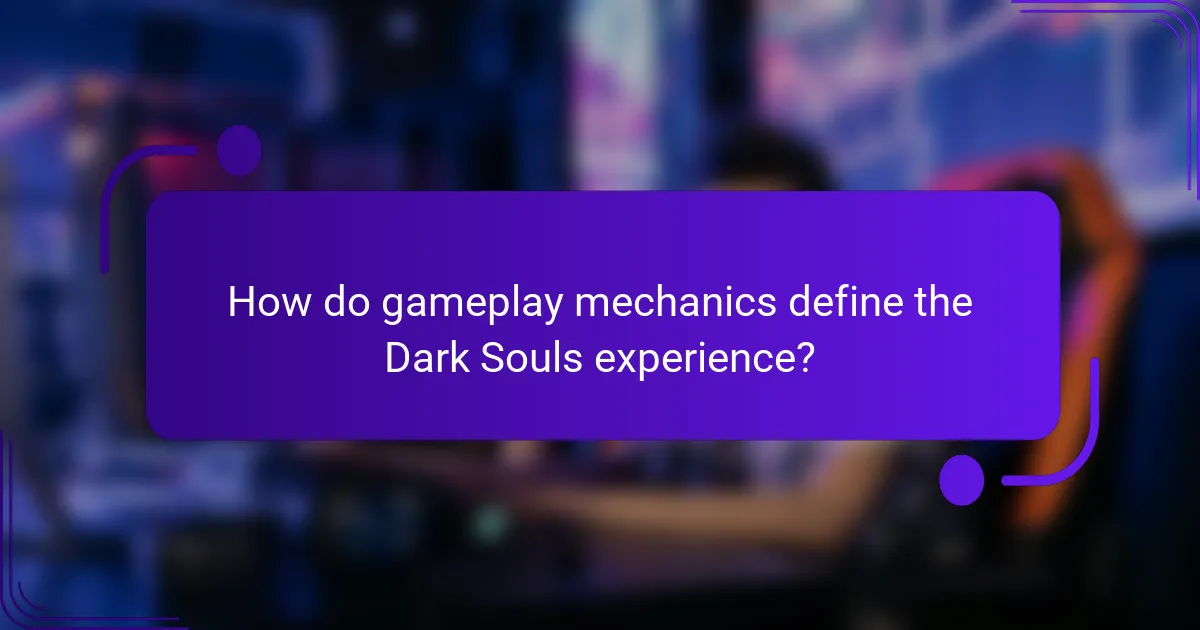
How do gameplay mechanics define the Dark Souls experience?
Gameplay mechanics are central to the Dark Souls experience, emphasizing challenge and strategic depth. The game’s combat system requires precise timing, stamina management, and a deep understanding of enemy patterns. Unique mechanics, such as the risk-reward system of losing souls upon death, heighten tension and encourage exploration. Additionally, the interconnected world design fosters a sense of discovery and immersion, reinforcing the game’s lore and atmosphere. This combination of difficulty, mechanics, and narrative creates a distinct and memorable gameplay experience.
What are the key combat mechanics and strategies?
Dark Souls features intricate combat mechanics that prioritize timing, strategy, and resource management. Key strategies include mastering dodging, understanding enemy patterns, and utilizing stamina effectively. Players should focus on attack timing, as well as the importance of positioning during encounters. Additionally, weapon choice and upgrades significantly impact combat effectiveness, allowing for tailored approaches to different enemies.
How does the stamina system influence player tactics?
The stamina system significantly influences player tactics in Dark Souls by limiting actions. Players must manage stamina to balance offense, defense, and mobility. Effective stamina management allows for strategic decision-making, such as when to attack or evade. This creates tension in combat, as players must anticipate enemy moves while conserving stamina for critical moments. Consequently, players develop unique tactics based on their playstyle and character build, emphasizing the game’s challenge and depth.
What types of weapons and armor are available, and how do they affect gameplay?
In Dark Souls, various weapons and armor types significantly influence gameplay through combat style, defense, and player strategy. Weapons include swords, axes, and bows, each offering unique attack patterns and damage types. Armor sets provide varying levels of protection and mobility, impacting stamina consumption and damage resistance.
Weapon types affect gameplay by determining attack speed and range. For instance, heavy weapons deal more damage but are slower, while lighter weapons allow quicker strikes. Armor impacts defense, with heavier sets offering greater protection at the cost of mobility. Players must balance their choices to suit their preferred playstyle, enhancing the game’s challenge and depth.
| Weapon Type | Attack Speed | Damage Type | Special Attributes |
|————-|————–|————-|——————–|
| Swords | Medium | Slash | Versatile |
| Axes | Slow | Crush | High damage |
| Bows | Fast | Pierce | Ranged attacks |
| Greatswords | Slow | Slash | Heavy damage |
| Daggers | Very Fast | Slash | Critical hits |
| Spears | Medium | Pierce | Reach advantage |
Choosing the right combination of weapons and armor is crucial for overcoming challenges in Dark Souls, as each player’s approach can lead to different gameplay experiences.
How does the level design challenge players?
The level design in Dark Souls challenges players through intricate environments that require exploration and strategic navigation. Players face interconnected pathways, hidden secrets, and formidable enemies that demand adaptability. The unique attribute of verticality in level design creates opportunities for ambushes, enhancing tension. Rarely, players encounter shortcuts that reward exploration, reinforcing the game’s theme of perseverance. Overall, the design fosters a sense of accomplishment through overcoming obstacles and mastering the world.
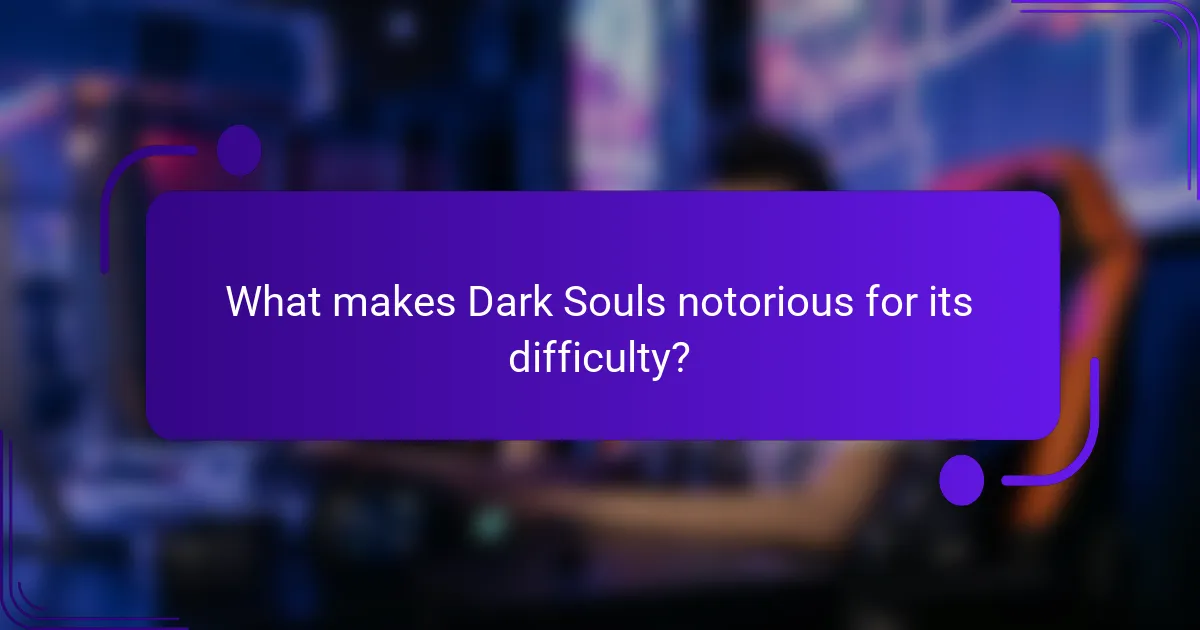
What makes Dark Souls notorious for its difficulty?
Dark Souls is notorious for its difficulty due to its punishing gameplay mechanics, intricate level design, and deep lore that enhances the challenge. Players face relentless enemies and complex boss battles that require precise timing and strategy. The game’s unique attribute lies in its minimal hand-holding, forcing players to learn from failures. Additionally, the interconnected world design creates a sense of vulnerability, as players can easily lose progress. The rarity of forgiving checkpoints amplifies the tension, making every encounter feel significant.
How do enemy designs contribute to the challenge?
Enemy designs in Dark Souls significantly enhance the challenge by introducing unique mechanics and strategies. Each enemy type possesses distinct attributes, such as attack patterns and weaknesses, requiring players to adapt their gameplay. For instance, larger foes may have powerful, slow attacks, while smaller enemies can overwhelm with speed. This variety demands critical thinking and skillful execution, enriching the overall experience. Additionally, rare enemy encounters often yield unique rewards, further incentivizing exploration and strategic engagement. The combination of these elements creates a dynamic and challenging environment that is central to Dark Souls’ appeal.
What are the common player mistakes that lead to failure?
Common player mistakes in Dark Souls include impatience, neglecting exploration, poor resource management, and failing to learn enemy patterns. These errors often lead to frustration and hinder progress. Players frequently rush into battles without understanding their surroundings, which can result in unnecessary deaths. Additionally, not utilizing items effectively can leave players underprepared in challenging encounters. Understanding the game’s mechanics and pacing is crucial for success.
How does the death mechanic impact player experience?
The death mechanic in Dark Souls significantly heightens player experience by emphasizing challenge and consequence. Players face a unique attribute where each death results in the loss of collected souls, creating tension. This mechanic fosters a sense of accomplishment when overcoming difficult encounters, reinforcing the game’s core theme of perseverance. As a result, players engage more deeply with the lore and gameplay mechanics, making each victory feel earned.
What strategies can players employ to overcome challenging sections?
Players can employ various strategies to overcome challenging sections in Dark Souls. Mastering enemy patterns is crucial; understanding attack timings allows for effective dodging and counterattacks. Utilizing the environment can provide tactical advantages, such as leading enemies into traps or using elevation for better positioning.
Upgrading weapons and armor significantly enhances survivability and damage output. Players should also consider using buffs, like temporary spells or consumables, to gain an edge in tough encounters.
Co-op play with other players can provide support in difficult sections, allowing for distraction and combined attacks. Finally, patience and persistence are vital; learning from each defeat gradually leads to success.
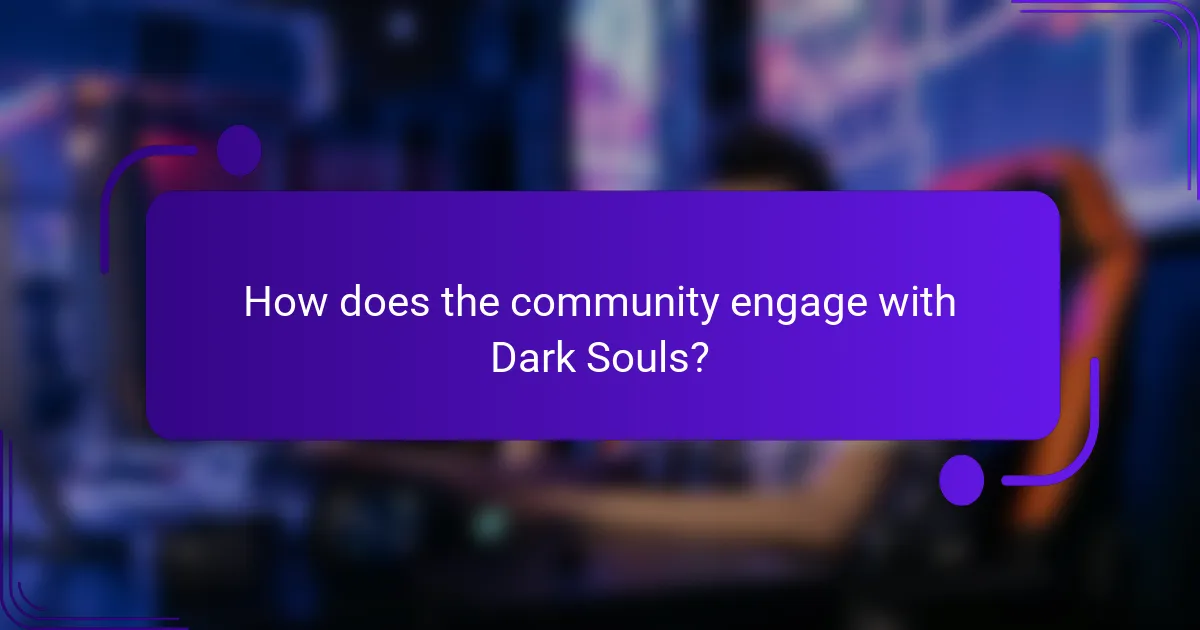
How does the community engage with Dark Souls?
The community engages with Dark Souls through discussions, fan theories, and multiplayer interactions. Players share lore interpretations and strategies, enhancing the game’s depth. Online forums and social media platforms foster collaboration and challenge sharing. Unique attributes like the game’s difficulty and interconnected world create a rich environment for community engagement. Additionally, fan art and lore videos contribute to the game’s cultural impact, showcasing player creativity.
What are the most popular fan theories about the lore?
The most popular fan theories about Dark Souls lore include interpretations of the Age of Fire, the cyclical nature of the world, and the connections between characters. Fans often discuss the significance of the First Flame, suggesting it represents a choice between light and dark. Another theory posits that the player character embodies the cycle of linking the fire, emphasizing the burden of choice. Additionally, some theories explore the relationships between key figures, such as Gwyn and his offspring, revealing deeper familial ties and conflicts. These theories enrich the game’s narrative, inviting players to engage with its complex lore.
How do multiplayer elements enhance or complicate gameplay?
Multiplayer elements in Dark Souls enhance gameplay by fostering cooperation and competition among players. They introduce unique dynamics such as summoning allies for challenging bosses or engaging in PvP duels. These interactions deepen the lore and challenge, creating memorable experiences. However, they can complicate gameplay by introducing unpredictability, as player behavior can vary widely. This complexity may deter some players seeking a more solitary experience. Overall, multiplayer elements enrich the game while adding layers of challenge and engagement.
What role does speedrunning play in the Dark Souls community?
Speedrunning plays a significant role in the Dark Souls community by fostering competition and collaboration among players. It showcases mastery of gameplay mechanics and challenges, emphasizing skill and strategy. Speedrunners often share techniques and routes, enhancing the overall understanding of the game’s intricate design. This community-driven approach creates a unique attribute of shared knowledge, enriching the lore and gameplay experience for all players. As a result, speedrunning not only highlights individual achievements but also strengthens community bonds through collective challenges.
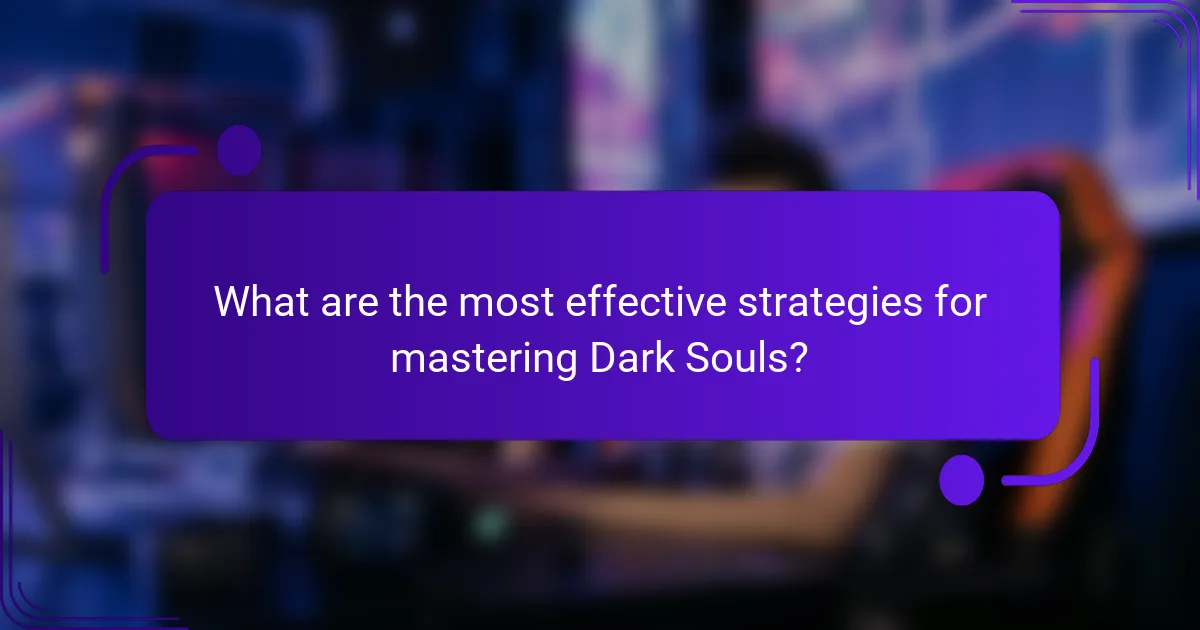
What are the most effective strategies for mastering Dark Souls?
To master Dark Souls effectively, players should focus on strategic gameplay, understanding lore, and embracing challenge.
1. Learn enemy patterns to anticipate attacks and counter effectively.
2. Experiment with different builds to find a playstyle that suits you.
3. Utilize the game’s lore to enhance immersion and motivation.
4. Practice patience; rushing leads to mistakes and frustration.
5. Engage with the community for tips and shared experiences.
6. Explore thoroughly to uncover hidden items and shortcuts.
What tips can help new players acclimate to the game?
New players can acclimate to Dark Souls by embracing patience, learning enemy patterns, and exploring thoroughly. Understanding the game’s mechanics, such as stamina management and the importance of timing, is crucial. Use the bonfire system wisely for checkpoints and resource management. Engage in cooperative play to learn from experienced players.
How can players improve their combat skills over time?
Players can improve their combat skills over time by practicing consistently and studying enemy patterns. Mastering timing and dodging enhances survivability. Utilizing different weapons and understanding their mechanics allows for adaptability in combat. Engaging with the community for tips and strategies can provide new insights into effective gameplay.
What resources are available for lore exploration and gameplay improvement?
Numerous resources enhance lore exploration and gameplay in Dark Souls. Online wikis provide extensive lore details, while forums foster community discussions. Video guides offer gameplay strategies and tips. Books and articles analyze themes and mechanics, deepening understanding. Additionally, fan-made content enriches the experience through creative interpretations and theories.